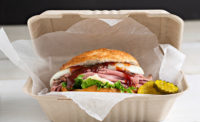
Even in a recession, time-strapped consumers are loath to give up eating out. However, they are easing the burden on their wallets — and their cooking skills — by picking up fresh, restaurant-quality prepared meals at grocery take-out displays and cafes.
“Retailers are trying to capture the take-out business that casual chains focus on,” says Ron Paul, president and CEO of Technomic Inc., a Chicago-based food industry research and consulting firm. “This time, prepared foods are not a blip like HMR [home meal replacements], which was basically retailers responding to the success of Boston Market with rotisserie chicken. They are a real trend and opportunity for retailers to capture business lost to casual chains.”
What’s old is new again. As the big 1980s blended into the 1990s, grocery stores embraced one-stop shopping with its in-store banks, video rentals and pharmacies — and increased store square footage. Stuffy home meal replacements and pre-marinated meats were offered to consumers looking for a ready-to-eat or ready-to-cook meal. Today’s supermarkets look different, but are providing convenience to time-strapped consumers with healthy, organic, ethnic and traditional prepared foods (ready to eat or heat and eat), drive-through pick-up lanes, photo development centers and even walk-in medical clinics.
Saving money and calories
The $25 billion ready-to-eat meal category, according to Technomic, is enticing to the 61 percent of consumers who make dinner at least twice a week and are looking for shortcuts. Indeed, 71 percent of consumers are cooking more and eating out less due to higher energy costs, reported the Washington, D.C.-based Food Marketing Institute (FMI).
It’s estimated that eating a meal at home costs $5 per person, compared to $12 to $15 per person at restaurants, notes Bill Greer, director of communications for FMI. Although cost is a big factor in consumers purchasing more prepared foods, it’s certainly not the only component. Simply, the food has to taste good as well. Retailers are trying to offer distinctive prepared foods to differentiate themselves from their competition, in addition to convenience and health.
“Consumers do have a broader taste in foods, due to cooking shows, magazines and travel,” says Greer. “But this interest will vary from store to store according to consumers’ lifestyles, generation, time available to eat and shop, and income levels.”
According to The NPD Group’s December 2008 Retail Meal Solutions report, the margin between retailers and quick-service restaurants (QSR) for meal solution dollars is shrinking. Last year, consumers purchased only 1 percent more ready-to-eat food, meals and snacks at QSRs than retailers. In fact, sales of prepared foods increased at retail by 2 percent.
“Consumers’ increasing use of foodservice for ready-made meals has long been recognized by grocery retailers as an opportunity,” says Bonnie Riggs, restaurant industry analyst and author of the Retail Meal Solutions report, from The NPD Group, a market research company. “For some time, retail stores have offered prepared foods in the deli department, but have now expanded foodservice offerings to include a variety of cold and hot ready-to-consume meals and snacks.”
Prepared foods are generally displayed next to or in the deli and meat departments, mostly as mix-and-match options with entrees, sides and desserts, individual or family-sized meals, or buffet bars. To emphasize their product freshness, some retailers are doing their prep work in front of customers, displaying their cooking areas and using carving stations, says Paul.
Because consumers perceive food sold at grocery stores to be healthier, some retailers are also hiring nutritionists and dieticians to counsel customers on food choices, provide store tours and review store recipes, says Greer.
Retailers are also helping younger shoppers with, well, meal solutions. Consumers used to shop with a planned menu for the week, but few customers shop that way anymore, notes Greer.
A history of convenience
The founders of California grocery chain Bristol Farms came out of the meatpacking industry and always emphasized quality meat and prepared foods. The 17-store grocery chain operates its own central kitchen for its service cases and prepared items and uses all-natural chicken and beef in its entrees.
“Prepared foods are a great continuing segment of our business,” says Steve Howard, senior director of foodservice for Bristol Farms, based in Carson, Calif. “People want good, wholesome food, more time with their families and less time in the kitchen cooking.”
Bristol Farms stays on top of new food trends by utilizing its executive chef Bruce Jabobs, a 15-year veteran, and a team of buyers who look for new, exciting items or ideas from vendors, foods shows, competitors and magazines.
Because its stores cover so many different ethnic areas, each store caters to its own unique demographic needs with Indian dishes or traditional entrees like shepherd’s pie and whole chickens, for example. About 10 to 12 stores use buffet bars, which offer Indian, Mexican and American foods. Then, the retailer provides another 25 to 35 entrees, fresh salads and sides.
Bristol Farms is different than other stores in that its prepared items are located separately from the deli, such as across the store or adjacent to it.
Focus on fresh
Fresh & Easy Neighborhood Market, the British chain Tesco’s first American grocery store, was designed from scratch to highlight prepared foods, with help from Tesco’s past knowledge and new research into the American market. Opened in November 2007, the 10,000-square-foot format doesn’t have room for a deli but instead features its prepared foods by the produce department and Kitchen Table, an area to sample new foods, which are in the heart of the store.
“Shoppers are looking for affordable but quality options,” says Brendan Wonnacott, spokesperson for Fresh & Easy, based in Sacramento, Calif. “Our products have no trans fats, artificial colors or flavors, and we only use preservatives when absolutely necessary.”
Since last year, Fresh & Easy has rolled out 450 branded items, most of them fresh prepared foods. The retailer offers full meals and a mix-and-match system of entrees and sides, including beef lasagna, shepherd’s pie and breakfast burrito. Well over 98 percent of Fresh & Easy’s fresh food is produced daily at a kitchen facility and delivered to its stores.
“In response to consumer feedback, we provide a lot of variety and options for families,” says Wonnacott. “Part of what has made Tesco and Fresh & Easy successful is listening to our customers, suppliers and neighbors.”
Raising the bar
Meat and poultry suppliers can jump on the convenience bandwagon by preparing their product as much as possible for consumers.
“For example, don’t just sell pieces of meat or chicken,” says Paul. “Bread it, stuff it or brown it so the consumer just has to put it in the oven.”
The emerging prepared-foods model is not without its own limitations for retailers. Their major problem is controlling waste, as they do not offer cook-to-order options like restaurants. Retailers are experimenting with smaller batches and trying to improve quality control, says Paul.
“The quality bar has been raised,” he says. “Retailers can’t put lasagna out at 10 a.m. and expect people to buy it at 5 p.m.”
Prepared foods are also labor intensive, says David Livingston, a supermarket consultant with Waukesha, Wis.-based DJL Research.
“It’s hard for grocers to duplicate restaurant quality and taste, along with made-to-order meals,” he says.
Prepared from scratch
Publix, the 1,000-store Southern grocery chain, is known for staying on top of the latest food trends. Over the past two years, the employee-owned company has experimented with take-out drive-throughs, a popular Aprons program that helps consumers with meal prep and assembly, and four Publix GreenWise Markets which feature 10 “culinary venues” of fresh prepared foods such as Asian, rotisserie, artisan sandwiches and salads, and Mediterranean oven selections.
Maria Brous, the director of media and community relations, for Lakeland, Fla.-based Publix Super Markets Inc., explains how the retailer develops its meal selection and works with meat and poultry suppliers.
The National Provisioner: Why invest in more advanced prepared foods programs today?
Brous: Our customers look to Publix for meal solutions. Our prepared foods areas allow customers the one-stop-shop option. They can find an assortment of selections for every member of their family and enough variety to satisfy every palate.
NP: How does Publix determine its meal or side dish selection?
Brous: At Publix, we have a meals department that works specifically on recipe development. Our customers let us know if we’ve hit the mark with their purchasing trends. We are very focused on customer feedback. We are consistently tweaking recipes and meal selections.
NP: How many ready-to-eat meals do you offer?
Brous: This would vary by location. For instance, at our Publix GreenWise markets, our health-, natural- and organic-food format stores, we offer over 100 different varieties of prepared foods. At our Publix Sabor locations, our Hispanic-food format, we offer over 50 varieties of prepared foods.
NP: How much input do you get from meat and poultry processors on your meal options?
Brous: We work closely with our suppliers; however, recipe development is an in-house process.
Maria Brous, the director of media and community relations, for Lakeland, Fla.-based Publix Super Markets Inc., explains how the retailer develops its meal selection and works with meat and poultry suppliers.
The National Provisioner: Why invest in more advanced prepared foods programs today?
Brous: Our customers look to Publix for meal solutions. Our prepared foods areas allow customers the one-stop-shop option. They can find an assortment of selections for every member of their family and enough variety to satisfy every palate.
NP: How does Publix determine its meal or side dish selection?
Brous: At Publix, we have a meals department that works specifically on recipe development. Our customers let us know if we’ve hit the mark with their purchasing trends. We are very focused on customer feedback. We are consistently tweaking recipes and meal selections.
NP: How many ready-to-eat meals do you offer?
Brous: This would vary by location. For instance, at our Publix GreenWise markets, our health-, natural- and organic-food format stores, we offer over 100 different varieties of prepared foods. At our Publix Sabor locations, our Hispanic-food format, we offer over 50 varieties of prepared foods.
NP: How much input do you get from meat and poultry processors on your meal options?
Brous: We work closely with our suppliers; however, recipe development is an in-house process.




Report Abusive Comment